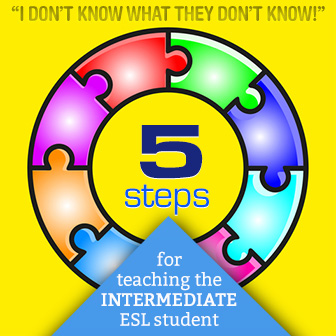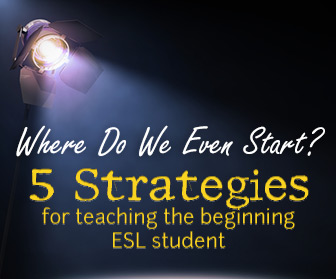I Donít Know What They Donít Know: 5 Steps for Teaching the Intermediate ESL Student


Beginning ESL students generally have deep respect for teachers and the learning process, often coming from cultures where these attitudes are still practiced and not having yet been exposed much to American attitudes, which are generally not so respectful. In addition, a beginning ESL class often has fun classroom activities such as songs, plays, and outings rather than dictations and research writing. And, let’s not forget to mention, beginning ESL students often give the teacher flowers at the end of the term, a practice common in many other countries.
However, there is still that sinking feeling that sometimes comes in about the second week of the term when working with very beginning students, when the instructor realizes the students really know little beyond “hello,” “yes,” and “no.” Where do we even start? Vocabulary? Grammatical structures? Basic literacy skills? Help! There is help available. Teaching the beginning ESL student need not be a difficult and bewildering process if some basic principles are addressed.

Traditional language instruction begins with teaching the alphabet, or numbers, or conjugating often-used verbs. It is, of course, difficult to take a needs assessment at this level, but we already know what beginning students really need is some basic greetings and farewells and other language for getting along in their communities, such as asking for directions or the costs of items. They don’t really need to conjugate the verb “to be,” although this may be taught in the context of introductions, for example: “I am Stacia; he is Gilliam…” The focus, however, should be on basic conversation; grammar should be taught in context of the conversational skills rather than as a focus on its own. Students should work in pairs or small groups much of the class period so that they can practice their English skills, preferably with speakers of languages other than their own, so that English is the common language the pair or group must use to communicate. This is in contrast to the traditional language instruction that most Americans have been exposed to and is still practiced in many parts of the world, where students sit in rows and wait for the teacher at the front of the room to call on them, and they may speak once or twice a class period, if that.
Students don’t need to know how to recite numbers and colors in their second language. People rarely do that in their first languages, for that matter. What students do need to know is how to give their birthdates and identification numbers or ask for a specific color of item in a store. Continue to focus on communicative needs of students and contextualize language in teaching students short dialogues for places they will be visiting like the store, a restaurant, a library, and so on.
Identify those language skills students will need to learn to survive in the community. What will they need to say in situations such as applying for a job, requesting a repair or refund on an appliance, looking for an apartment, visiting the doctor’s office, and so forth? When students have enough English, take a needs assessment, either oral or written, to find out which life skills are most important to them: looking for housing or talking to a doctor, for example? Have them practice dialogues in groups or pairs, and they may even perform short sketches in front of the class.
Students will need to learn academic language in English, of course—how to read and write it and analyze its grammar. Begin working on these skills while students continue work on life skills: have students read short nonfiction or fiction pieces related to their interests, answer questions about them, and write responses.
Give short lectures on important topics, such as the structure of the U.S. educational system, and have students take brief notes.
Toward the end of the term, begin discussing with students various school/career options. Many students, of course, will already have identified such goals, but they may be less sure on how to go about accomplishing them as our educational system and its connections to the workplace can be a complex maze even to students born in this country. Begin by identifying several educational options locally: for example, the community college and state university and then go beyond that, as necessary. Also discuss several possible career paths that are available from studying at those institutions, and it is likely at least one or two students will be interested: there are always one or two students in my beginning ESL classes who express interest in the dental assistant and nursing fields from studying at the local community college, for example. Find out what careers students are already interested in and discuss where they might get information on this field: a number of students have an interest in pharmacy, for example, and a nearby private college, University of the Pacific, has a recognized pharmacy department with several programs. You might consider having a school counselor or representative from a department of student interest come in to your class to talk about opportunities.
But with some persistence, focusing on communication and transitioning to academic skills, the teacher can take her class from novices to students ready to begin the journey toward their academic lives and careers!